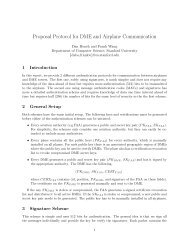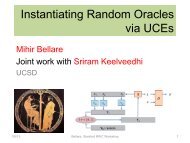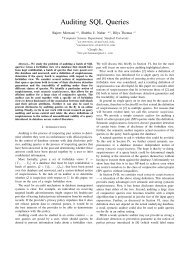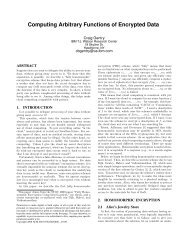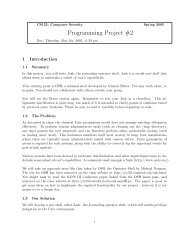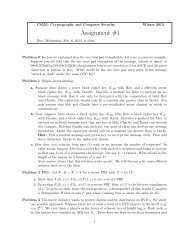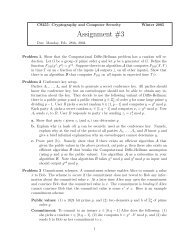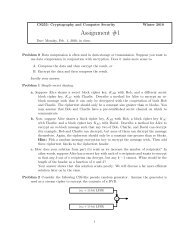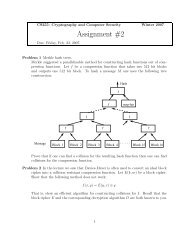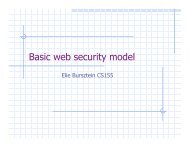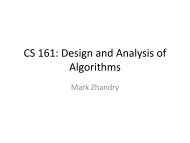Encryption Schemes from Bilinear Maps - Eu-Jin Goh
Encryption Schemes from Bilinear Maps - Eu-Jin Goh
Encryption Schemes from Bilinear Maps - Eu-Jin Goh
You also want an ePaper? Increase the reach of your titles
YUMPU automatically turns print PDFs into web optimized ePapers that Google loves.
<strong>Encryption</strong> <strong>Schemes</strong> <strong>from</strong><br />
<strong>Bilinear</strong> <strong>Maps</strong><br />
<strong>Eu</strong>-<strong>Jin</strong> <strong>Goh</strong><br />
PhD Thesis Defense<br />
30 May 2007
<strong>Encryption</strong> <strong>Schemes</strong><br />
Provide data confidentiality<br />
• building block of crypto protocols<br />
• two main types :<br />
1. Symmetric Key Enc (e.g. DES, AES)<br />
• Same key used to encrypt and decrypt<br />
2. Public Key Enc (e.g. RSA)<br />
• Public key used to encrypt<br />
• Private key to decrypt<br />
• Much slower than symm key enc<br />
• Focus of this talk
<strong>Encryption</strong> <strong>Schemes</strong> <strong>from</strong><br />
<strong>Bilinear</strong> <strong>Maps</strong><br />
1. Traditional pub key enc schemes<br />
• e.g. El Gamal, RSA<br />
• based on finite groups of prime or<br />
composite order<br />
2. <strong>Bilinear</strong> groups<br />
• finite groups on certain elliptic curves<br />
with special function called bilinear map<br />
• can build enc schemes on bilinear groups
<strong>Bilinear</strong> groups<br />
Thesis<br />
allow us to build pub key enc schemes<br />
with properties that are difficult to<br />
obtain using “traditional” groups<br />
To support thesis, give 2 schemes we built<br />
• Homomorphic enc scheme [BGN05]<br />
• Hierarchical IBE [BBG05]
Part 1 :<br />
Homomorphic <strong>Encryption</strong>
What is Homomorphic <strong>Encryption</strong>?<br />
Enc. scheme is homomorphic to function f if<br />
• <strong>from</strong> E[A], E[B], can compute E[f(A,B)]<br />
• e.g. f can be +, ×, ⊕, …<br />
• no secrets needed to compute<br />
e.g. El Gamal ( × homomorphic )<br />
CT 1 = (g a , g sa × M 1) CT 2 = (g b , g sb × M 2)<br />
CT1 × CT2 = (g a+ b , g s(a + b) × M 1 M 2)
Doubly Homomorphic <strong>Encryption</strong><br />
Enc. scheme is homomorphic to function f if<br />
• <strong>from</strong> E[A], E[B], can compute E[f(A,B)]<br />
• e.g. f can be +, ×, ⊕, …<br />
Ideally, want f = NAND, or f = {+,×}<br />
• Called doubly homomorphic encryption<br />
Can do universal computation on ciphertext!
Why is doubly homomorphic<br />
encryption useful?<br />
Efficient solution for many problems:<br />
Most generally<br />
1. 2 party Secure Function Evaluation<br />
Specific problems<br />
• Computing on encrypted databases<br />
• Distributed computing on confidential<br />
data
App: Database Computation<br />
Outsourced server with database containing<br />
encrypted data<br />
• User wants to compute function g on<br />
encrypted data<br />
• e.g. data mining, data aggregation<br />
With doubly homomorphic encryption,<br />
• Database encrypted with doubly hom. enc.<br />
• User sends g to server<br />
• Server computes g on encrypted database<br />
• Encrypted result returned to user
These applications are<br />
pretty cool,<br />
what does a doubly homomorphic<br />
encryption scheme look like?<br />
Sorry, it doesn’t exist (yet).<br />
• Open problem <strong>from</strong> 1978 (Rivest et. al.)<br />
• Existing schemes hom. to 1 function<br />
• E.g. ElGamal (×), Paillier (+), GM (⊕)<br />
But made some progress …
Our Results<br />
Two homomorphic encryption schemes that<br />
support one × and arbitrary +<br />
⇒ Eval multi-var polynomials of total deg 2<br />
1. Subgroup decision scheme<br />
• Built <strong>from</strong> finite bilinear groups with composite order<br />
• Security based on subgroup decision problem<br />
2. Linear scheme<br />
• Built <strong>from</strong> finite bilinear groups with prime order<br />
• Security based on linear problem<br />
For talk, focus on subgroup decision scheme
Related Work<br />
Sander et al. [SYY99]<br />
• Enc. scheme — NC 1 circuit eval. on CTs<br />
⇒ Can evaluate 2-DNFs on CTs<br />
But CT len. exponential in circuit depth<br />
• CT size doubles for every + op<br />
• Poly. len. 2-DNF gives poly. size CT<br />
• Our schemes — constant size CT<br />
— crucial for apps
<strong>Bilinear</strong> groups with<br />
composite order n<br />
For prime p = ln – 1 and p = 2 mod 3<br />
• G = subgroup of points in F p on<br />
elliptic curve y 2 = x 3 + 1 (order n)<br />
• G 1 = subgroup of F p2 (order n)<br />
Weil pairing on curve gives bilinear map<br />
e: G × G → G1 where<br />
1. e (u a , v b ) = e (u , v) ab<br />
2. e (g , g) ≠ 1 (g = generator of G)
Keygen(τ):<br />
Enc. Scheme<br />
• G: bilinear group order n = q 1 q 2 on ell. curve over F p .<br />
• Pick rand g,u ∈ G. Set h = u q 2 (⇒ h order q1 )<br />
• PK = (n, G, G 1 , e, g, h) SK = q 1<br />
Encrypt(PK, m): m ∈ {1,…,T}<br />
• Pick random r <strong>from</strong> Z n .<br />
• Output C = g m h r ∈ G.<br />
Decrypt(SK, C):<br />
• Let C q 1 = ( g m h r ) q 1 = (g q 1) m<br />
• Output m = Dlog of C q 1 base v.<br />
; v = g q 1<br />
Note: decrypt time is O(√T).
Given A = g a h r and B = g b h s :<br />
To get encryption of a + b<br />
Homomorphisms<br />
• pick random t ∈ Z n<br />
• compute C = A ⋅ B ⋅ h t = g a+ b h r + s + t ∈ G<br />
To get encryption of a × b<br />
• let h = g αq 2 , g 1 = e(g,g), h 1 = e(g,h)<br />
• pick random t ∈ Zn • compute<br />
C = e(A,B) ⋅ h<br />
t<br />
=<br />
ab r’<br />
1 g1 h1 ∈ G1
Challenger<br />
Semantic Security<br />
For encryption schemes, standard notion of<br />
security is semantic security.<br />
Modeled as game btw adversary and challenger<br />
Adversary<br />
Keygen(τ)<br />
PK<br />
Pick 2 msgs<br />
Pick random<br />
bit b∈ {0,1}<br />
M0 , M1 E[Mb] M0, M1 (same len)<br />
Output guess<br />
for b<br />
Sem sec ⇒ can’t guess b with prob different <strong>from</strong> ½<br />
⇒ can’t distinguish btw ciphertexts
Complexity Assumption<br />
Decision subgroup assumption:<br />
For rand. bilinear group G of order n = q 1q 2 ,<br />
given (n,G,G 1,e,x), the distributions :<br />
• x is uniform in G<br />
• x is uniform in q1—subgroup of G<br />
are indistinguishable<br />
Thm: system is semantically secure, unless the<br />
subgroup assumption is false.
Security of <strong>Encryption</strong> Scheme<br />
Proof Sketch :<br />
1. Assume enc scheme is broken<br />
• ⇒ exists adversary A that can win semantic<br />
security game with prob better than ½<br />
• use A to break complexity assumption<br />
• i.e. given (n, G, G1 , e, x), use A to determine if<br />
x is in q1 subgroup of G<br />
2. Create simulator S that interacts with A to<br />
distinguish x with prob better than ½
Proof of Semantic Security<br />
Simulator<br />
Given (n,G,G1,e,x), decide if x ∈ q1 subgroup of G<br />
Pick rand g ∈ G<br />
Pick random<br />
bit b ∈ {0,1}<br />
PK = (n,G,G 1,e,g,x)<br />
M 0 , M 1<br />
E[M b] = g m b x r<br />
Adversary<br />
Pick 2 msgs<br />
M0, M1 Output b’<br />
If x ∈ q1 subgroup of G, then E[Mb] valid CT<br />
If not, then E[Mb] independent of b
Applications<br />
1. Evaluate multi-variate polynomials of<br />
total degree 2 (on ciphertexts)<br />
2. Gadget: “check” if CT contains 1 of 2 values<br />
• Most voter efficient E-voting scheme<br />
• Universally verifiable computation<br />
3. SFE for 2-DNF formulas ∨ (b i,1 ∧ b i,2 )<br />
4. Build first perfect NIZK argument for all NP<br />
languages [GOS06]<br />
• 20 year old problem in NIZK
1) Evaluating Quadratic Poly.<br />
Multi-var polynomials of total deg 2<br />
• x 1 x 2 + x 3 x 4 + …<br />
• +, × hom. allow eval. of such poly. on CT<br />
• e.g. e (E[x 1] , E[x 2]) × e (E[x 1] , E[x 2]) × …<br />
• evaluate dot products<br />
• but to decrypt, result must be in known<br />
poly. size interval.
Suppose CT: C = E[v].<br />
Given 2 msgs v0,v1 and rand r, anyone can compute<br />
E [ r ⋅ (v - v0) ⋅ (v - v1) ]<br />
• If v ≠ v 0 ,v 1 , result is E[random]<br />
• Otherwise, result is E[0]<br />
2) Gadget<br />
• Decryptor can verify CT is enc. of either v 0 or v 1<br />
• but not learn which one<br />
Applications:<br />
1. E-voting: voter ballots need no NIZK proofs<br />
2. Universally Verifiable Computation<br />
• Anyone can check that public function on private inputs<br />
computed correctly without learning anything else
4) Perfect NIZK for all NP lang.<br />
GOS06 builtperfectNIZK forcircuitsat<br />
(CSAT) using our enc scheme<br />
NIZK for CSAT ⇒ prove that circuit C is<br />
satisfiable without revealing formula that<br />
satisfies C<br />
CSAT = NP-complete
Key observations :<br />
4) NIZK for CSAT<br />
• can build NIZK proof that CT contains enc of 0 or 1<br />
• our enc scheme also commitment scheme<br />
• If A, B, C commitments to bits<br />
C = A NAND B iff A + B + 2 (C – 1) ∈ {0,1}<br />
can use homomorphic properties + NIZK proof to verify RHS<br />
If A, B input wires of NAND gate and C output wire<br />
• use NIZK proof to show that A, B, C are enc of bits<br />
• compute RHS and verify result with another NIZK proof<br />
⇒ NAND gate well formed<br />
• Then use this construction in circuit to show satisfaction<br />
without revealing formula
Secure Function Evaluation<br />
2 parties : Alice and Bob<br />
• Alice has function f and Bob has input x<br />
• Both want to evaluate f(x) without<br />
revealing f to Bob and x to Alice<br />
Two security models :<br />
1. Alice/Bob is semi-honest<br />
• follow protocol exactly but can learn secret info<br />
<strong>from</strong> interaction (honest but curious)<br />
2. Alice/Bob is malicious<br />
• can do anything they like but assume that<br />
Alice/Bob still interested in learning f(x)<br />
• can’t prevent aborting, not participating, using<br />
input y instead of x, …
Bob<br />
A = (a1,…,an) ∈ {0,1} n<br />
4) 2 Party SFE for 2-DNF<br />
Alice<br />
φ(x1,…,xn) = ∨k i=1(yi,1∧yi,2) s.t.<br />
y i,* ∈ {x 1,¬x 1,…, x n,¬x n}.<br />
Get Arithmetization Φ:<br />
• replace ∨ by +, ∧ by ×, ¬xi by (1- xi). • Φ is poly. with total deg 2!
2-DNF Protocol (Semi-Honest)<br />
Bob<br />
A = (a1,…,an) Invoke Keygen(τ)<br />
Encrypt A<br />
If decrypt = 0,<br />
emit 0. Else, 1.<br />
PK, E[a 1],…,E[a n]<br />
E[r ⋅ Φ(A)]<br />
Alice<br />
φ(x1,…,xn) = ∨k i=1(yi,1∧yi,2) Φ = arith. of φ<br />
Eval. E[r ⋅ Φ(A)]<br />
for random r<br />
Bob’s Security: Alice cannot distinguish bet. Bob’s<br />
possible inputs — <strong>from</strong> semantic security of E.<br />
Alice’s Security: Bob only knows if A satisfies φ() — by<br />
design, Bob output distrib. depends only on this.
SFE for 2-DNF<br />
1. Communication Complexity = O(n⋅τ)<br />
• garbled circuit comm. comp. = Θ(n 2 )<br />
2. Secure against unbounded Bob<br />
3. Also have protocol secure against<br />
malicious Bob (in paper)
Concrete application for 2-DNF<br />
Improve basic step in Kushilevitz-Ostrovsky<br />
PIR protocol <strong>from</strong> √n to 3 √n<br />
• PIR = Private Information Retrieval<br />
• Bob wants entry j in database<br />
• but does not want database or any<br />
eavesdropper to know j<br />
• Trivial solution : send whole db<br />
• want more communication efficient sol<br />
• optimize for comm., not computation
PIR/SPIR<br />
Bob: wants D(R,S)<br />
Set assignment A:<br />
x R = y S = 1,<br />
x i = x j = 0<br />
for i ≠ R, j ≠ S<br />
Do 2-DNF SFE<br />
with A and φ<br />
Get φ(A) = D(R,S)<br />
Database D<br />
√n<br />
|D| = n<br />
√n<br />
D uses 2-DNF<br />
φ(x 1,…,x √n, y 1,…,y √n)<br />
= ∨ D(i,j)=1 (x i ∧ y j)<br />
If Comm. D(R,S) Complexity = 0 ⇒ (xR ∧ yS = ) ∉O(τ φ. Then ⋅√n) φ(A) [O(τ = 0 ⋅if xR = yS = 1 in A.<br />
If D(R,S) = 1 ⇒ (xR ∧ yS ) ∈φ. Then φ(A) = 1 if xR = yS = 1 in A.<br />
3√n) balanced]<br />
Alternative scheme — each db entry O(log n) bits
End of Part 1 : Homomorphic Enc<br />
Two homomorphic enc schemes that support one ×<br />
and arbitrary +<br />
• based on subgroup decision and linear problems<br />
Despite only one additional mult, still many useful<br />
applications :<br />
1. Dot products, quadratic poly<br />
2. 2-DNF, PIR<br />
3. Voting, verifying computation<br />
4. Perfect NIZK for NP
Questions?
Part 2 :<br />
Identity Based <strong>Encryption</strong>
Identity Based <strong>Encryption</strong> (IBE)<br />
IBE — Pub key enc system [S84,BF01,C01]<br />
• In IBE, pub keys can be arbitrary strings (ID)<br />
• Traditional Pub Key Enc :<br />
• need user to have pub/priv key pair before can enc msgs to user<br />
• IBE : since pub key can be arbitrary string<br />
• can encrypt to user using public id (e.g. email addr)<br />
• Central auth (CA) issues priv key to user for public id<br />
CA<br />
ID1 ID2 …<br />
ID99
Hierarchical IBE (HIBE)<br />
HIBE — IBE generalization [HL02,GS02,BB04]<br />
• ID with priv keys can issue priv keys to<br />
descendent IDs<br />
• e.g. with priv key for ID = (A1 ,A2 ),<br />
can create priv key for ID = (A1 ,A2 , * , …)<br />
CA<br />
ID1 ID2 … ID99<br />
ID1,ID1 ID1,ID2 … ID1,ID99 …
Applications<br />
ID hierarchy can mirror organization hier.<br />
• Delegate key generation to subordinates<br />
HIBE is a building block for:<br />
• Forward Secure Enc<br />
• Private key evolves over time s.t.<br />
CT enc with key at time n cannot be dec with priv<br />
key <strong>from</strong> time > n<br />
• Public Key Broadcast Enc<br />
• Broadcast enc = enc msg to large user base with<br />
ability to revoke users<br />
• E.g. DVD enc scheme - AACS
Main Result<br />
Existing HIBEs — HL02, GS02, BB04<br />
CT size and dec cost linear with hierarchy depth<br />
Our HIBE —<br />
1. CT size and dec cost constant with hier depth<br />
• CT Size = 3 group elmts , Dec Cost = 1 pairing<br />
2. Priv key size shrinks as go down ID hierarchy<br />
3. Selective ID Security in Standard Model<br />
• <strong>Bilinear</strong> DH Inversion Problem (BDHI) [BB04]
Using our HIBE in Applications<br />
Existing HIBEs — GS02, BB04<br />
CT size, dec cost linear with hierarchy depth.<br />
Forward Secure Enc<br />
• GS,BB — CT size, Dec cost = O( log(time) )<br />
• Ours — CT size, Dec cost = O(1)<br />
Broadcast Enc N = # users, r = # revoked users<br />
• GS,BB — CT size = O(r log N)<br />
• Ours — CT size = O(r)
HIBE Scheme<br />
Setup(l):<br />
• G: bilinear group order p. HIBE max depth = l.<br />
• Pick rand g, g 2, g 3, h 1, … , h l ∈ G , α ∈Z p. Set g 1 = g α .<br />
• Params = (g, g 1 , g 2 , g 3 , h 1 , … , h l ) Master Key = g 2 α<br />
KeyGen(d ID*, ID): ID* = (I 1 , … , I k ) ID = (I 1 , … , I k+1 )<br />
• d ID* = ( g 2 α ·(h1 I1 ··· hk Ik ·g3 ) r , g r , h k+1 r , … , hl r ) rand r,t ∈ Zp<br />
= ( a 0, a 1 , b k+1 , … , b l)<br />
• d ID = ( a 0 ·b k+1 Ik ·(h1 I1 ··· hk+1 Ik ·g3 ) t , a 1 ·g t , b k+2 h k+2 t ,…, bl h l t )<br />
Encrypt(Params, ID, m): ID = (I 1 , … , I k )<br />
• Pick rand s ∈ Zp. • Output C = ( e(g1 ,g2 ) s · M , gs I1 Ik , (h1 ··· hk ) s ).<br />
Decrypt(d ID, CT): CT = (A,B,C) d ID = (a 0 , a 1 , b k+1 …, b l )<br />
• Output A · e(a 1 ,C) / e(a 0 ,B)
IND-sID-CCA Security [BF01]<br />
Challenger Adversary<br />
Setup Alg<br />
Pick rand bit b<br />
ID*<br />
Pub params<br />
Either ID or E ID[M]<br />
Priv key for ID or M<br />
M 0, M 1<br />
E ID*[M b]<br />
Priv key and<br />
Decrypt<br />
Queries<br />
Challenge<br />
More Queries<br />
except challenge<br />
Output guess b’. Win if b’ = b.
Security Theorem<br />
l th <strong>Bilinear</strong> DH Inversion assumption [BB04]:<br />
G = <strong>Bilinear</strong> group of prime order p<br />
e : G × G → G 1<br />
For rand generators g, h ∈ G, and rand α ∈Z p*<br />
then following two distributions indistinguishable:<br />
• ( g , h , g (α) , g (α2) , … , g (αl) , e(g,h) 1/α )<br />
• ( g , h , g (α) , g (α2) , … , g (αl) , T ) for rand T ∈ G1<br />
Thm: HIBE system is IND-sID-CCA, unless l-wBDHI<br />
assumption is false.
End of Part 2 : HIBE<br />
HIBE with constant size CT and dec cost<br />
• Secure in Standard Model<br />
• Weak <strong>Bilinear</strong> DH Inversion Assump.<br />
Open Problem:<br />
• Fully Secure HIBE with tight reduction
<strong>Bilinear</strong> groups<br />
Conclusions<br />
allow us to build pub key enc schemes<br />
with properties that are difficult to<br />
obtain using “traditional” groups<br />
Gave 2 examples :<br />
• Subgroup Decision homomorphic enc scheme<br />
• Hierarchical IBE
My Publications<br />
1. Securing Remote Untrusted Storage<br />
• NDSS 2003<br />
2. Key Recovery in TLS<br />
• ISC 2003<br />
3. Signature scheme with tight security<br />
• <strong>Eu</strong>rocrypt 2003<br />
4. Effectiveness of Address Space Randomization<br />
• ACM CCS 2004<br />
5. Event driven private counters<br />
• FC 2005<br />
6. Evaluating 2-DNF formulas on Ciphertext<br />
• Theory of Cryptography 2005<br />
7. Hierarchical IBE with constant size Ciphertext<br />
• <strong>Eu</strong>rocrypt 2005<br />
8. SFE using Ordered Binary Decision Diagrams<br />
• ACM CCS 2006<br />
9. Privacy in RFID<br />
• Currently in submission<br />
10. Secure Indexes<br />
• Technical Report
Acknowledgements<br />
1. my advisor : Dan Boneh<br />
2. thesis committee members<br />
• John Mitchell, Rajeev Motwani, Dawson Engler,<br />
Nancy Zhang<br />
3. my coauthors<br />
• Hovav Shacham, Stanislaw Jarecki, Xavier<br />
Boyen, Kobbi Nissim, Philippe Golle, Aviv<br />
Nisgav, Louis Kruger, Somesh Jha, Matthew<br />
Page, Ben Pfaff, Nagendra Modadugu, Benny<br />
Pinkas, Ari Juels, Dan Bailey, Brent Waters<br />
4. the Stanford Crypto and Security Group<br />
5. the support of my wife, family, and friends
Questions?



